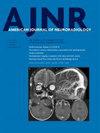The many faces of myxopapillary ependynomas.
IF 3.7
3区 医学
Q2 CLINICAL NEUROLOGY
引用次数: 0
Abstract
Myxopapillary ependymomas (MPE), classified as grade 2 tumors by the WHO, are rare spinal neoplasms. Despite their slow growth and generally benign nature, MPE have a high recurrence rate and potential for cerebrospinal fluid dissemination. This study aims to identify the MRI characteristics and pathological patterns of MPE and investigate potential correlations between the MRI characteristics and specific histopathological patterns. We assessed 13 patients (7 men; mean age, 45.1 years) with pathologically proven MPE. MRI images were reviewed for tumor location, size, T1 and T2 signal characteristics, contrast enhancement, hemosiderin cap presence, vertebral scalloping, drop metastasis, and prominent intradural flow voids. Four histopathological patterns (microcystic, solid, hemorrhagic, and high hyalin content) were defined and segmented, with surface areas measured and percentages calculated relative to the total tissue surface. Most tumors were in the lumbar region (84.61%), with MRI revealing typical features such as T2 hyperintensity (100%) and contrast enhancement (92.3%). A rare non-enhancing MPE was noted. Large tumors exhibited a microcystic pathology pattern, with two cases with this pattern showing drop metastasis on MRI. Smaller tumors typically presented a solid pathology pattern with homogenous MRI signals. This study underscores the diverse MRI presentations of MPE and suggests a potential link between microcystic patterns in pathology and large MPE with drop metastasis.ABBREVIATIONS: MPE= myxopapillary ependymoma.肌乳头状上皮瘤的多面性。
肌乳头状上皮瘤(MPE)被世界卫生组织列为 2 级肿瘤,是一种罕见的脊柱肿瘤。尽管 MPE 生长缓慢且一般为良性,但其复发率高,并有脑脊液播散的可能。本研究旨在确定 MPE 的 MRI 特征和病理模式,并探讨 MRI 特征与特定组织病理学模式之间的潜在相关性。我们评估了 13 位病理证实为 MPE 的患者(7 位男性,平均年龄 45.1 岁)。核磁共振成像检查了肿瘤位置、大小、T1和T2信号特征、对比度增强、血色素帽的存在、椎体扇形、点滴转移和突出的硬膜内血流空洞。对四种组织病理学模式(微囊性、实性、出血性和高透明质含量)进行了定义和分割,并测量了表面积,计算了相对于组织总表面的百分比。大多数肿瘤位于腰部(84.61%),磁共振成像显示出典型特征,如T2高密度(100%)和对比度增强(92.3%)。罕见的非增强型 MPE。大肿瘤呈现微囊病理形态,其中两例在核磁共振成像上显示有点滴转移。较小的肿瘤通常表现为具有均匀磁共振成像信号的实性病理形态。这项研究强调了MPE在核磁共振成像上的多种表现形式,并提示病理学上的微囊形态与伴有点滴转移的大型MPE之间存在潜在联系:MPE=肌乳头状上皮瘤。
本文章由计算机程序翻译,如有差异,请以英文原文为准。
求助全文
约1分钟内获得全文
求助全文
来源期刊
CiteScore
7.10
自引率
5.70%
发文量
506
审稿时长
2 months
期刊介绍:
The mission of AJNR is to further knowledge in all aspects of neuroimaging, head and neck imaging, and spine imaging for neuroradiologists, radiologists, trainees, scientists, and associated professionals through print and/or electronic publication of quality peer-reviewed articles that lead to the highest standards in patient care, research, and education and to promote discussion of these and other issues through its electronic activities.

 求助内容:
求助内容: 应助结果提醒方式:
应助结果提醒方式:


